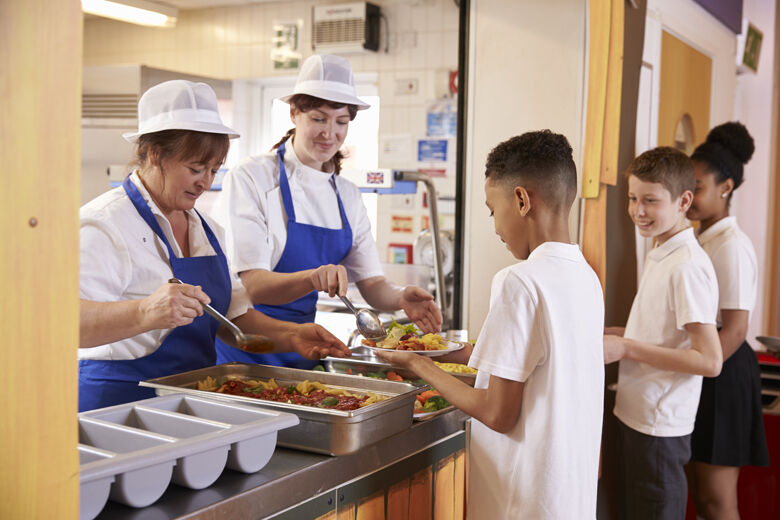Welcome to the School Zone, WTOP’s weekly feature about the latest topics and trends in education across the D.C. region.

What to know about free lunches this school year
What it is: During the last two school years, any student attending a public school who wanted a school lunch was able to receive one for free.
The free lunches were made possible by the U.S. Department of Agriculture, the agency tasked with leading school lunch initiatives. The agency waived an eligibility requirement, enabling any student, regardless of things like family income, to take a free lunch.
The program ended this summer, though, meaning many school systems will revert to pre-pandemic, free-and-reduced meal plans. Students will be eligible for free or reduced-price meals based on the family’s salary.
Families didn’t have to fill out an application for students to get free lunches during the last two school years, but entering the 2022-23 academic year, many families may have to apply to be eligible, as was the case before the pandemic.
What it means: Many more students took advantage of the free meals during the pandemic, The Associated Press reported.
In the last school year, 30 million students were getting free meals daily, compared to 20 million before the pandemic, according to the USDA.
In Prince William County, Virginia, there was a 10% to 15% increase in demand for free meals last year, Adam Russo, the county’s director of food and nutrition services, told me.
Free meals will still be available schoolwide in select D.C.-area schools under the Community Eligibility Provision, a USDA program that enables schools in low-income areas to offer free food to all students.
Regional snapshot: Thirty-seven schools in Prince William County qualify for the Community Eligibility Provision, Russo told me. He said about 44% of families in the county qualify for free or reduced-price meals.
In Montgomery County, Maryland, a spokesman said families who don’t apply and qualify will have to pay for meals.
In Arlington, Virginia, students who qualify are encouraged to sign up for free and reduced-priced meals.
In Fairfax County, Virginia’s largest school system, over 30 schools qualify for schoolwide free meals under the Community Eligibility Provision. Students receiving benefits from the Supplemental Nutrition Assistance Program or who receive Temporary Assistance for Needy Families might automatically be eligible for free meals, the county said.
In all cases, applications are usually available on school websites.
Talking points: Russo, in Prince William County, said, “In other parts of the country, or places that I’ve spoken with, people think of the meal program as a free meal program, and people don’t want to take advantage because they think that that’s only for certain people, when quite frankly, yummy food is for all people. And the more people that we serve, it drives our cost down right through economies of scale.”
Study: Many DC drivers speed in school zones
In a report this week, traffic analytics company INRIX said many D.C. drivers speed in the city’s school zones.
I spoke to WTOP’s Nick Iannelli for the latest.
Q: What did the INRIX report find about driver habits in school zones?
A: The report found that in many cases, D.C. drivers ignore signs around school zones that tell them they need to slow down. About 20% of drivers go at least 10 mph above the 15 mph speed limit that is posted in those zones.
More speeding is happening around schools with lower-income students.
For example, roughly 24% of drivers near schools in lower-income areas traveled faster than 25 mph in the 15 mph areas, compared with 17% near schools in upper-income areas.
Also, speeding and crash rates didn’t vary much between school zone and nonschool zone streets.
Q: Were there any positive trends detailed in the report?
The report didn’t necessarily find anything “positive,” but it did find that crashes around schools — when they occur — are generally less severe when compared to crashes along roads that are not in school zones.
Fatalities and major injuries were lower.
That could be because speeds, overall, are lower near schools when compared with major corridors where speed limits are higher.
[Read more about Nick’s story on speeding in school zones on WTOP.com]
By the numbers
Some data that caught my eye this week.
Substitute shortage: The number of substitute teachers on the D.C. Public Schools payroll fell from nearly 1,000 in the first quarter of 2020 to about 500 in the first quarter of 2022, according to data from the D.C. Policy Center.
D.C. Mayor Muriel Bowser increased substitute teacher pay twice last school year in an effort to expand the city’s substitute pool.
What Scott’s Reading
- How to pay it forward and help Virginia kids who need backpacks for school [WTOP]
- Hundreds of LGBTQIA+ students raise concern about draft Va. policy [WTOP]
- Alexandria unveils security enhancements at public schools [WTOP]
- Hundreds of MCPS support staff vacancies will cause district to ‘suffer’ if not filled, union president says [Bethesda Beat]
- An autism-friendly outing to see Blue Man Group — without the stares [Washington Post]
- Increases in opioid overdoses and behavioral health issues seen among Fairfax County youth [InsideNova]
Field Trip
Here’s a fun thought ahead of the weekend.
Another attempt at the minions: If all goes well, perhaps it’s finally time to check out “Minions: The Rise of Gru.” If not, well, we can just keep binging “Ozark.”








